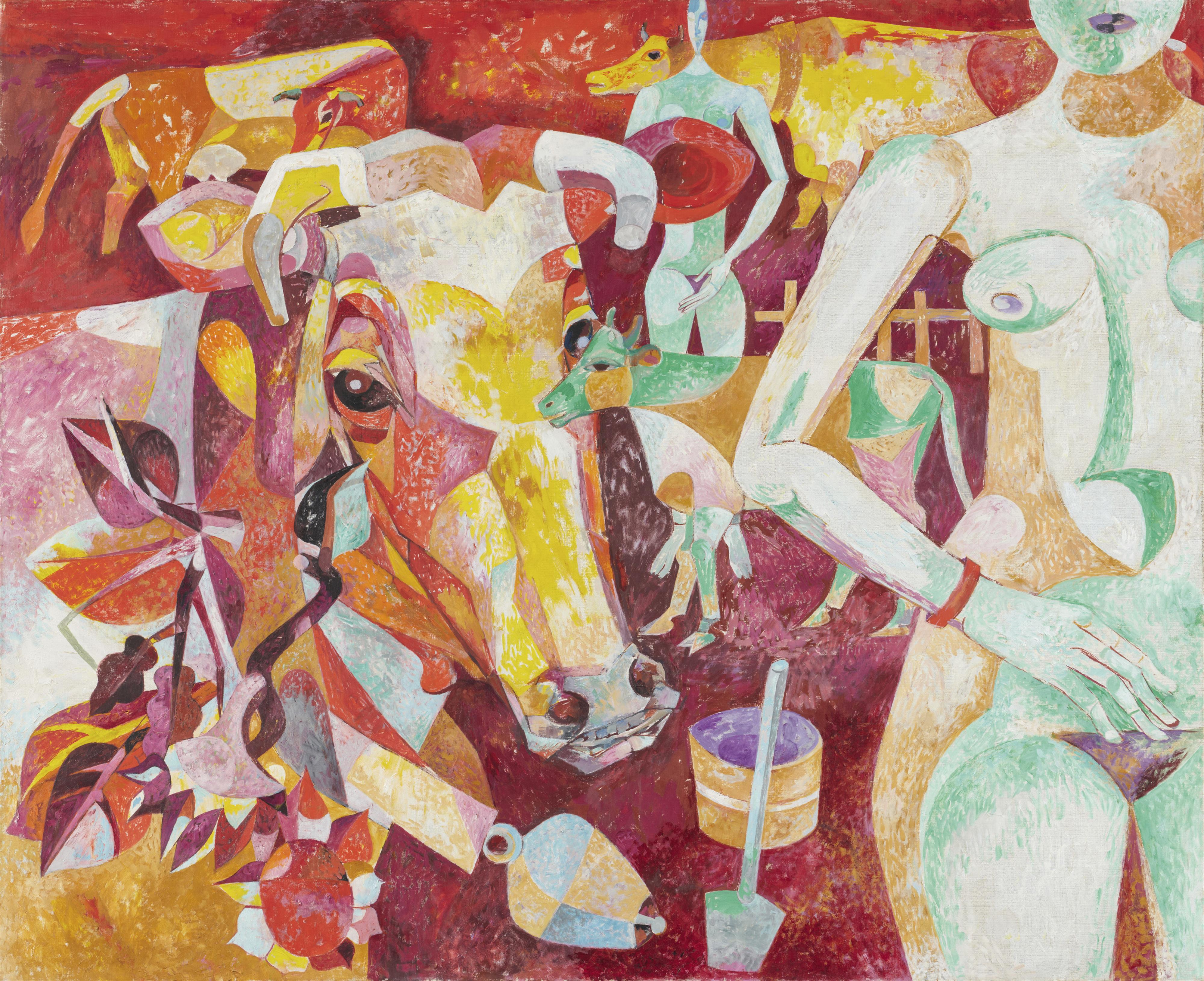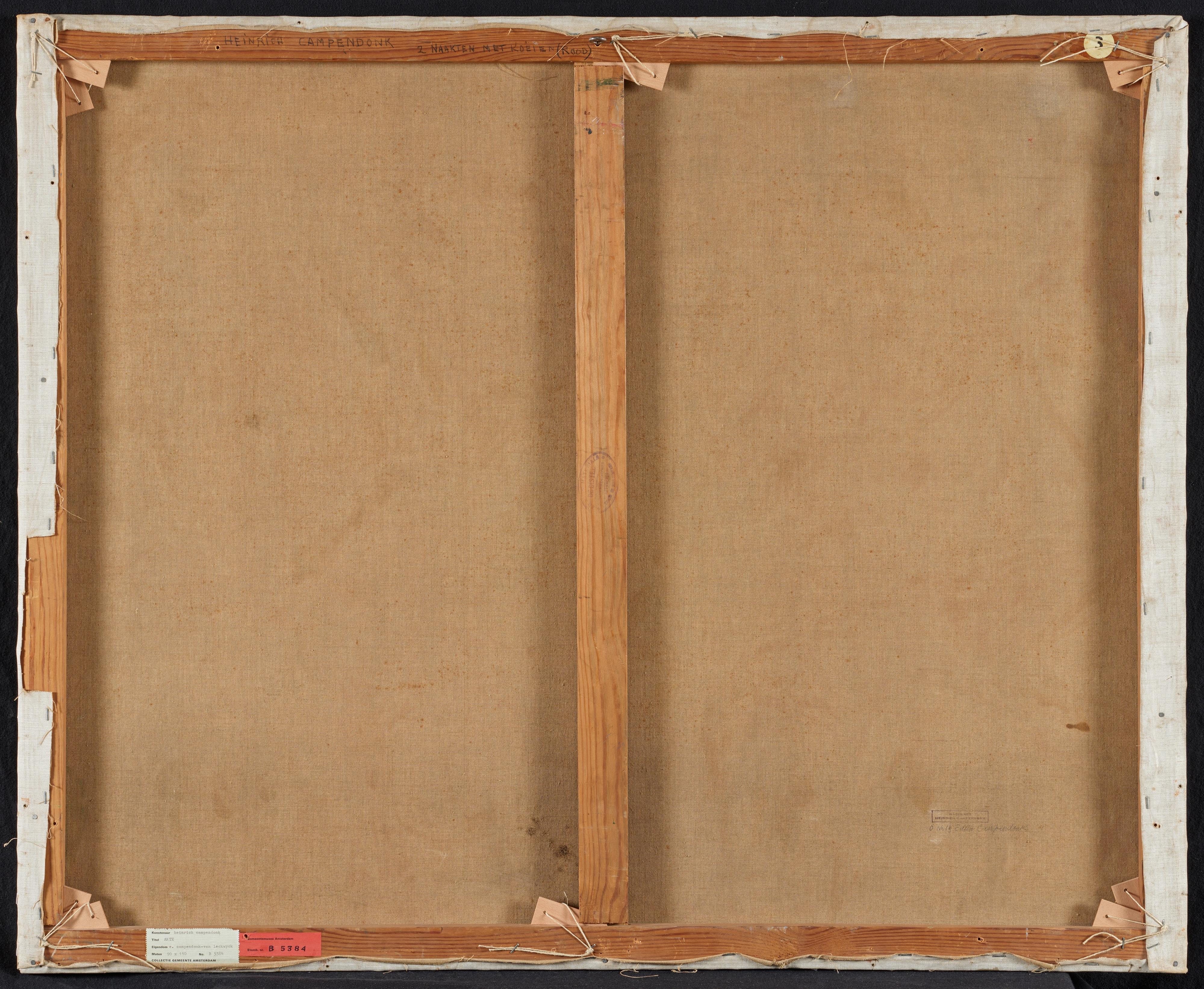Heinrich Campendonk
Akt mit Kühen
Circa 1949
Oil on canvas. 90.5 x 110.5 cm. Framed under glass. Unsigned. Stamped on the reverse of the canvas "NACHLASS HEINRICH CAMPENDONK" and inscribed in pencil "Ö Nr.15 Edith Campendonk". - On the reverse side of the stretcher with the printed label of the Collectie Gemeente Amsterdam, typed with the artist's name, the title of the picture "AKTE" and the owner "e. campendonk-van leckwyck", the format and the inv. no. "B 5384". Inscribed on the upper stretcher "HEINRICH CAMPENDONK 2 NAAKTEN MET KOEIEN (ROOD)". - In excellent condition with very fresh colours.
Heinrich Campendonk had been a professor at Düsseldorf’s academy of art since 1926; in 1934 the Nazi regime dismissed him from his post and his works were denounced as “degenerate”. The artist emigrated to the Netherlands, where he was offered a position at the Rijksakademie in Amsterdam. As a progressive artist he met with rejection among his colleagues at this conservative school, but he enjoyed great admiration from students and loved teaching. Although he was briefly arrested after the German army invaded in 1940 and was later forcibly conscripted to perform guard duty for the German occupation’s security forces, he was able to continue teaching until the end of the war. He additionally designed stained-glass windows for public buildings in the Netherlands.
In 1947 the artist began working intensively as a painter again; his work was included in exhibitions in Krefeld and Düsseldorf and he was also offered a position at Düsseldorf’s academy of art. However, he ultimately decided against returning to Germany: he remained deeply troubled by his experience of denunciation for the rest of his life.
In his late work he built on his earlier oeuvre in terms of motifs – as had previously been the case, lyrical images of animals and landscape elements from his local surroundings are to be found throughout these works, sometimes in combination with female nudes. This final phase of his oeuvre is defined by a coolness and clarity of colour and form. “Only now have our eyes become open to the beauty of these late works, with their depressive immobilisation seen as a potential and valid expression of the experience of suffering, as a thoroughly artistic attempt to tame life’s power to escape us”, writes Gisela Geiger (in: exh. cat. Heinrich Campendonk. Rausch und Reduktion, Stadtmuseum Penzberg 2007, p. 99).
Our two magnificent, large-format paintings from the period around 1949 fascinate us with their intense luminosity and clearly contoured forms, which reflect his many years working with stained glass. The diverse details of the motifs are poured into crystalline fields of colour and interwoven into dense tapestries of images. Campendonk’s unsurpassed feel for colour, which distinguished his oeuvre from the very beginning, expresses itself in a harmoniously balanced equilibrium of cool and warm tones.
Catalogue Raisonné
Firmenich 1190 Ö
Provenance
Estate of the artist; thenceforth owned by the Campendonk family; Depositum Stedelijk Museum Amsterdam
Exhibitions
Bedburg-Hau/Amstelveen 2001/2002 (Stiftung Museum Schloss Moyland/Cobra-Museum voor moderne kunst), Heinrich Campendonk: die zweite Lebenshälfte eines Blauen Reiters, cat. no. 64, colour ill. p. 165; Delmenhorst 2002 (Städtische Galerie Haus Coburg), Heinrich Campendonk - Melancholie und Ornament. Das malerische Spätwerk, n. p., n. ill.; Permanent loan Museum Penzberg, Sammlung Campendonk 2016-2023




